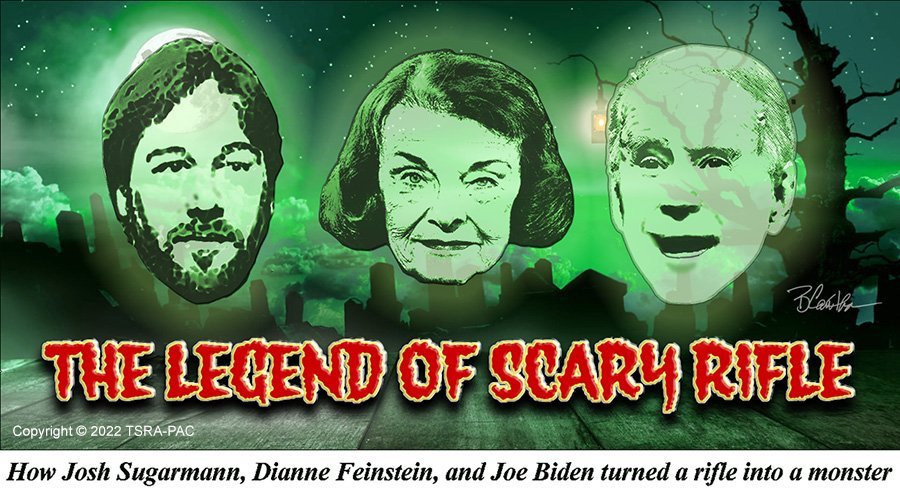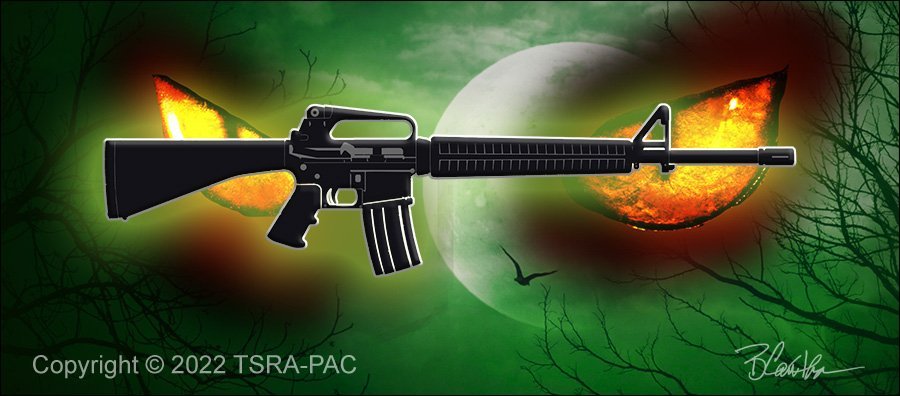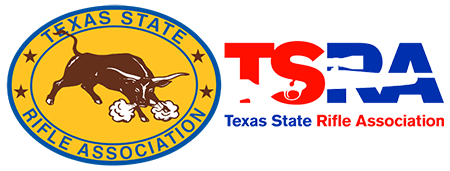THE LEGEND OF SCARY RIFLE
by TSRA Admin
A long time ago, in Hollywood, Eugene Stoner developed a new style of rifle in the hopes that the Army would like it. Unfortunately, he was late to the competition, and, even though many liked his rifle, someone else won the prize.
A few years went by and the Army was unhappy with their new rifle. It was too big, too heavy, and soldiers couldn’t carry enough cartridges for it. Clearly, a new, lighter cartridge was needed and a new, lighter rifle was needed as well.
It fell to Robert Fremont, Stoner’s chief assistant, and Jim Sullivan, a wizard when it came to downsizing, to take Stoner’s earlier rifle and make it smaller.
The duo succeeded and they called the new rifle the Armalite AR-15. It was three pounds lighter and six inches shorter than the Army’s rifle. It also had less recoil, so it was easier for soldiers to shoot well. This was very important, because the rifle could fire in two ways, either one shot each time the trigger was pulled or continuously until the trigger was released. The first way is called semi-automatic; the second way is called fully automatic or simply automatic. A rifle that is able to fire in both ways is called ‘selective-fire’. This is important, so don’t forget it.
The new cartridge allowed warfighters to carry more than twice as much ammunition for the same weight allowance, a huge plus in the spray-and-pray days of jungle fighting in Southeast Asia.
Even with such a marvelous rifle, the Army was reluctant to change (as armies tend to be), but a general in the Air Force saw what Fremont and Sullivan had created and placed a large order, totaling thousands of rifles.
Eventually, even the Army realized the AR-15 was the right rifle and adopted it as the M16.
By that time, Armalite had sold the rights to the AR-15 to Colt Patent Firearms. Colt, being well aware of the potential market for such a rifle, developed a version that was not selective-fire and would only fire one cartridge per pull of the trigger. It was semi-automatic only. This rifle, which Colt called the “AR-15 Sporter”, was announced at the end of 1963.
Semi-automatic rifles weren’t new: the first semi-automatic rifle developed for American hunters went on sale 60 years before the AR-15 was announced. It was only a few more years before sportsmen could buy them with detachable magazines holding up to 20 cartridges. One company bragged that its rifle could fire five shots per second.
But the AR-15 was revolutionary in its own way. Not only was its pistol grip more comfortable, but the design allowed for things like adjustable-length stocks, meaning people of different sizes could shoot it comfortably. Moreover, Stoner’s modular design allowed barrels chambered for different calibers to be easily exchanged, meaning the same rifle could be used to hunt different types of game.
In short, the AR-15 was just as well-suited to the American hunter as the M16 was well-suited to the American soldier.
But there were dark clouds in the AR-15’s future. As the drug wars heated up in the 1980s, the cartels and gangs were arming themselves with guns such as the MAC-10 and Uzi, as well as the AR-15 and AK-47. In addition, mass shootings were on the rise. From a total of five in the 1960s, the number rose to ten in the 1970s, 23 in the 1980s, and 37 in the 1990s. AR-15s were used in three of these.
To be clear, that’s three times out of 38 mass shootings over more than 25 years,
Clearly, it was time for something to be done.
That “something” began with Josh Sugarmann, who is still making a nice living as the head of the Violence Policy Center, which he founded in 1988. Sugarmann wanted to mold public opinion so he coined the term “assault weapon” to make rifles like the AR-15 and AK-47 sound more dangerous. Sugarmann reasoned that the average American would think any firearm that looked like a machine gun was a machine gun, even if they weren’t.
Politicians jumped on the bandwagon and U.S. Senators Dianne Feinstein and Joe Biden pushed hard for a ban on guns that looked like military weapons. Ironically, their list included the AR-15 and AK-47 but not the M1 carbine, which not only was a military weapon but at that time had been used more frequently in mass shootings than either the AR or AK. The politicos also overlooked the Ruger Mini-14 in its Ranch Rifle configuration but included the Tactical version, which was exactly the same rifle with a different stock.
They got their way, after a fashion. An Assault Weapons Ban was passed with great fanfare in 1994 and signed into law by President Bill Clinton. The ban didn’t actually ban anything other than the sale of any new guns on the list to private citizens as well as a limit of ten rounds on new magazine capacities. Any guns and magazines that were already owned were okay. Senator Feinstein wasn’t satisfied and grumped on national TV that if she could have gotten the votes, Americans would have had to surrender their guns. Senator Feinstein not only didn’t know anything about guns, she didn’t know anything about Americans, either.
Thankfully, a sunset clause was inserted into the ban and we only had to live with it for ten years. The ban fans were upset that it wasn’t renewed but the truth is that the ban didn’t do anything other than be inconvenient. [For more on the ban and its aftermath, see “Busting Biden’s Ban” right here at the TSRA-PAC website.]
The AR-15 was a bit player in the rising tide of mass shootings. Out of 126 incidents from August 1966 to December 2014, AR-15s were present at seven, but only used in six.
Then came the shocking tragedy at Sandy Hook Elementary School. What the killer did was absolutely horrific. The gun control gang was quick to fixate on the Bushmaster clone of the AR-15. Calls for new bans on “assault weapons” came from everywhere and the more “progressive” media, always a handmaiden to gun control, was eager to repeat them endlessly. But this time, the focus was on the AR-15: Just the AR-15. Ignoring the fact that Sandy Hook was only the seventh mass shooting incident in which an AR-15 was actually used out of 127 mass shootings in 30 years, it became the poster child for the Evil Black Rifle.

The AR-15 became the boogeyman of firearms.
Ban fans and the media made the AR-15 a legend. It seems as if there was a competition to see who could spin the most outlandish tale. It was described as “high-powered” and capable of incredible rates of fire. To this day, claims are made like the .223 bullet is faster than any other bullet. In fact, as many of you know, this is simply not true. The fastest factory-loaded bullet is the .220 Swift, introduced back in 1935, and even the .243 Winchester, a popular cartridge for deer, will outrace the .223 Remington/5.56×45 NATO bullet.
Doctors who apparently have never treated anything other than injuries from handguns get positively lurid in their description of wounds.
The Big Lie was working. Most of the public only saw the propaganda; the truth was never allowed to be heard. The lie became accepted as the truth, just as George Orwell wrote in 1984.
And thus, the monster was born. The gun control mavens forgot that the public included wannabe mass shooters and that mass shooters tend to be copycats. They also forgot that no sane person takes a tool and kills people with it.
After Sandy Hook, AR-15s were used in 23 mass shootings and present, but not used, in a 24th – out of 53 mass shootings. The AK-47, which had been involved in more incidents than the AR-15 before Sandy Hook, virtually disappeared: Only four shooters chose AK-style rifles and none of them have used an M1 carbine or Ruger Mini-14.
Yet the same people who made the monster are the same ones calling for bans. They made a mess and now they want everyone else to clean it up – especially gun owners.
But how big a threat is this monster? This “killing machine,” which we have been told is suitable only for killing people despite the fact that millions of hunters, farmers, and ranchers use them regularly and, for many, it’s part of their business.
According to the National Shooting Sports Foundation, Americans own about 24 million modern sporting rifles, which includes the AR-15 and its clones, the AK-47, AK-74, SKS, WASR, and similar rifles from FN and H&K.
From the first use in 1977 to the most recent incident in Raleigh, a total of 55 AR-style rifles, including both AR-15s and the larger AR-10, Stoner’s original design, have been involved in mass shooting incidents. That total includes 22 assorted AR-15s and AR-10s stockpiled by the Las Vegas killer. There have been 168 mass shootings since 1977.
The AR-15 itself has been the best-selling type of rifle in the U.S. for a while. It’s probably safe to say that at least ten million of that 24 million modern sporting rifles are ARs. That would mean that 0.00055% have been used in mass shootings.
So, not only did they lie to create the monster, they are lying to make it seem like some existential threat to the nation. Of course, these are the same people who say the U.S. has had 550 mass shootings this year and include suicide in gun violence.
Guns are tools, just like chainsaws. Chainsaws, as you know, are so dangerous they make movies about them! It isn’t the tool that’s the problem, it’s the user. DWI is illegal and we don’t blame the bottle of alcohol or the car (also a tool), we blame the driver when they kill people, so why are the Progressives blaming the tool, here and not in other killings? Because it feels good and makes the politicians look good. But nobody ever contradicts them; nobody even gets to challenge them face-to-face. And that’s the really scary part.

